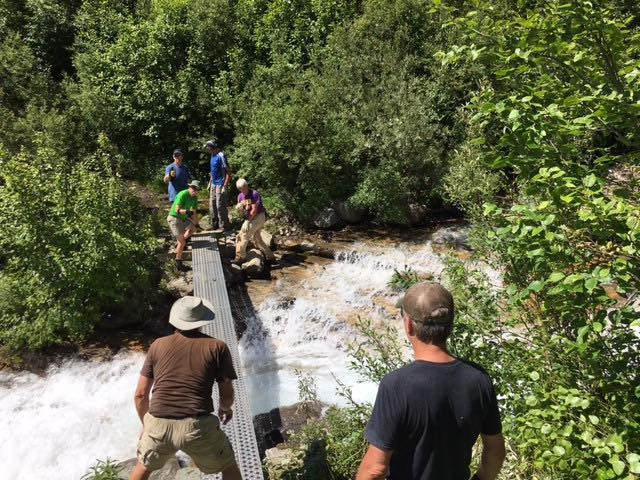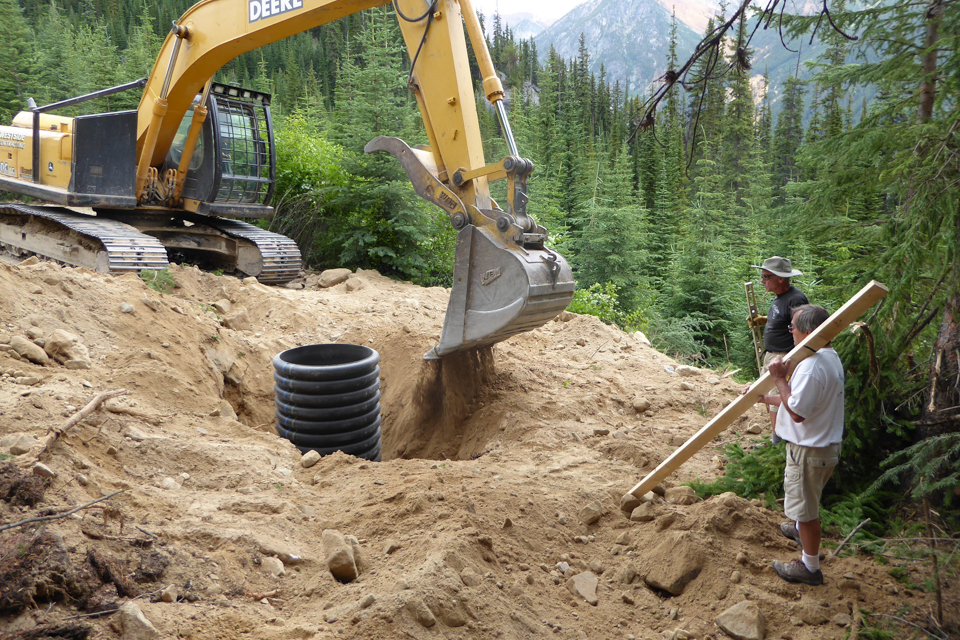
Summit Trail Makers installing an aluminum bridge over Hell Roaring Creek on the Lake of the Hanging Glacier trail this spring. The bridge is a key for access to one of most scenic trail destinations in western Canada. In addition, the STM keeps the 8.5-km trail clear of deadfall and has improved toilet facilities at the lake. The group is assisted by an annual grant from B.C.’s Ministry of Forests, which also shares the cost of trail crew liability insurance. Photo courtesy of Summit Trail Makers.
Parks and wilderness recreation managers across North America are increasingly turning to volunteer trail crews to help maintain backcountry facilities.
With the exception of the Jasper Trail Alliance, Parks Canada has rejected volunteer help, despite a steady reduction in trail maintenance and a deterioration in backcountry infrastructure.
Administrators provide a vague list of reasons for rejecting volunteer participation. Parks Canada’s Public Service Alliance of Canada (PSAC) union supports expanded facility and trail maintenance, but opposes the use of volunteer labour (for obvious reasons).
While Parks Canada rationalizes more than two decades of backcountry decline, there are success stories in many parks and wildlands across North America, including the mountain National Parks’ backyard—British Columbia’s upper Columbia Valley.
Summit Trail Makers Society
One of Canada’s most successful volunteer groups is the Summit Trail Makers Society (STMS), based in Invermere, B.C. The volunteer organization was formed by local hiking enthusiasts in 2001 as a way for hikers to “give back” and help the Ministry of Forests with trail development and maintenance.
The STMS built credibility with the Ministry of Forests during its first decade. Today it provides a level of maintenance well beyond that of most volunteer groups, including the use of chainsaws and power brush cutters. The group currently maintains eight high-profile trails in the Purcell Range and Rockies above the upper Columbia Valley ranging in length from 4.0 to 8.5 km.
The Ministry of Forests oversees STMS projects, provides an annual grant to help fund work, and shares the cost of liability insurance. One of the group’s annual duties is the early summer installation and autumn removal of an aluminum bridge over Hell Roaring Creek, which is key to accessing the 8.5-km trail to Lake of the Hanging Glacier, a popular destination in the Purcells.

Summit Trail Makers often recruit local contractors and their heavy equipment for backcountry improvements. STMS members watch during the installation of toilet facilities at the Welsh Lakes trailhead. John Pitcher photo.
Funding for special projects comes from a variety of sources in the upper Columbia Valley. In 2017, the Columbia Basin Trust supported a new loop trail to a lofty alpine ridge on the popular Pedley Pass trail with a $17,500 grant. And for separate work on the Chalice Creek trail near Bugaboo Lodge, Canadian Mountain Holidays loaned the use of one of its helicopters to lift a STMS crew clearing avalanche debris.
The group regularly improves trailhead parking areas and installs signage and toilet facilities. In a district where rough logging tracks provide access to most trails, it frequently adds road improvements to its list of duties: brushing roadsides, repairing water bars, and working with local heavy-equipment operators to improve road surfaces. And when requested, STMS works on trails that aren’t included within its eight-trail mandate.
The Summit Trail Makers website keeps hikers abreast of conditions and the latest improvements on each of its trails. And STMS members have been the primary source of detailed information for the Greenways’ Columbia Valley Guide to regional trails, which is undoubtedly one of the most sophisticated digital resources in North America.
A model for parks
The Summit Trail Makers Society is a unique and unusual model compared to most volunteer organizations. Over the course of 16 years, it has developed into a fully functional unit that can create and maintain trails as well as backcountry signage and facilities, and it does so with the blessing and financial support from the Ministry of Forests.
But how can volunteers be used to supplement existing trail crews in the National Parks? In a future posting, I will explore the history of the Jasper Trail Alliance in Jasper National Park—the only group of volunteer trail minders in the mountain national parks.

0 Comments